The
Washington, Jefferson & Madison Institute ("WJMI") offers public and private
secondary teachers a program of ten core courses to earn Virginia DOE annual recertification points for
re-licensure and a certificate of completion as a “WJMI Fellow” in the study of
the “American Founding Principles and Documents.” Each course consists of four 50-minute lectures or
presentations by distinguished scholars and authors with discussions and
Q&A. Through this series of intensive seminars on America’s Founding
Documents and the lives and writings of the Founding Fathers, teachers will
examine founding principles and original source documents for use in the
classroom. WJMI
Seminars are offered semi-annually in September and February at Prospect
Hill near Charlottesville.
Jefferson & Madison’s Guide to the
Constitution
Explore the original curriculum for the
teaching of the Constitution at the University of Virginia as set forth by
Thomas Jefferson and James Madison and the Board of Visitors on March 4, 1825.
Key documents that will be studies are Locke’s Second Treatise on Government, Sidney’s Discourses Concerning Government, the Declaration of Independence, Federalist Nos. 1, 10, 39, 51, 78 and
84, and Washington’s Farewell Address.
George Washington
Explore the character and statesmanship of
George Washington through his religious beliefs and political philosophy and
his life as the Commander of the Continental Army, the Constitutional
Convention, first President of the United States, and his Farewell
Address. Key documents that will
be studied are the Rules of Civility, the Nicola Letter, the Circular Letter to
the States, the Speech at Newburgh, the Retirement Speech to Congress, the
First Inaugural, the First Thanksgiving Message, and the Farewell Address.
James Madison
Explore the statesmanship and writings of
founder James Madison through his struggle for religious liberty, the
Constitutional Convention, the ratification of the Constitution, the creation
of the Bill of Rights, and the party struggle of the 1790s. Key documents that will be studied
include the Virginia Declaration of Rights, the Memorial & Remonstrance,
the Virginia Statute for Religious Freedom, Madison’s Notes to the Constitutional Convention, excerpts from the Federalist, Madison June 8, 1789 speech,
the Bill of Rights, and the essay “On Property.”
Thomas Jefferson
Explore the work of Thomas Jefferson for
religious and civil liberty and republican self-government through the making
of the Declaration of Independence, his diplomatic mission to France, his
thoughts on the Constitution, the party struggle of the 1790s, his presidency,
and his founding of the University of Virginia. Key documents that will be studied are the Summary View of
the Rights of British America, the draft and final copy of the Declaration of
Independence, the Virginia Statute for Religious Freedom, exchange of letters
with James Madison about the Constitution, his opposition to the Bank of the
US, the Kentucky Resolutions, the First Inaugural Address, and his exchange of
letters with John Adams.
Alexander Hamilton
Explore the life and constitutionalism of
Alexander Hamilton through his arguments for a stronger central government
during his Revolutionary War writings, the Constitutional Convention, the
Ratification of the Constitution, and as the Secretary of the Treasury during
the Washington administration. Key
documents that will be studied are the Farmer Refuted pamphlet, the June 18
speech at the Constitutional Convention, excerpts from the Federalist, the Report on Public Credit, the Opinion on the
Constitutionality of the Bank of the US, and the Pacificus-Helvidius
Debate.
John Adams
Explore the life and statesmanship of John
Adams through his political philosophy, marriage to Abigail Adams, battles for
American independence, his constitutional work in Massachusetts, his diplomacy
in Europe, and his vice-presidency and presidency. Key documents that will be studied are the letters with
Abigail Adams, his Dissertation on Feudal and Canon Law, Novanglus Essay, Thoughts on Government, the
Massachusetts Constitution, A Defense of
the Constitutions of Government of the United States, the First Inaugural
Address, the Alien and Sedition Acts, and his exchange of letters with Thomas
Jefferson.
Benjamin Franklin
Explore the life and statesmanship of Benjamin
Franklin through his Autobiography,
his 13 Virtues, his diplomacy in Europe, the alliance with France, and the
Peace Treaty, and his role in the Constitutional Convention. Key documents that will be studied are
his Autobiography, Poor Richard’s Almanac, Article in the
Federal Gazette on the “Structure of Government,” Speeches at the
Constitutional Convention, and the Petition for the Abolition of Slavery.
Religion & the Founding of the
American Republic
Explore the role of religion on the colonists
and the War for Independence, its influence on the American Founding, the
religious beliefs of the Founders, the effects of the Enlightenment, and the
relationship between religion and a virtuous Republic. Key documents to be studied are the
Declaration of Independence, the Virginia Declaration of Rights, Proclamations
of Thanksgiving and Fasting, the Virginia Statute for Religious Freedom,
Madison’s Memorial and Remonstrance,
the First Amendment to the Constitution, and George Washington’s Letters to the
Congregations.
The Constitution and its Ratification
Explore the events leading to the
Constitutional Convention, the philosophical sources of principles of the
Constitution, the debates in the Constitutional Convention, and the debates and
process of ratification. Key
documents to be studied include the Articles of Confederation, selections from
Locke, Sidney, and Montesquieu, Madison’s Notes
of the Debates in the Constitutional Convention, and excerpts from Anti-Federalist
writings and the Federalist Papers.
The Bill of Rights
Explore the Colonial origins of American liberties, the state constitutions, the debate over a Bill of Rights during the Constitutional Convention and ratification, the correspondence between Jefferson and Madison, and the significance and meaning of the First Amendment. Key Documents to be studied are A Summary View of the Rights of British America, The Farmer Refuted, the Virginia Declaration of Rights, the Bill of Rights, and James Madison’s June 8, 1789 Speech in the House of Representatives.







